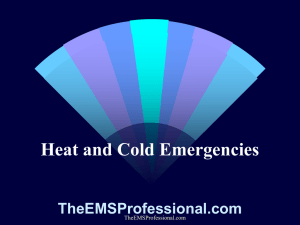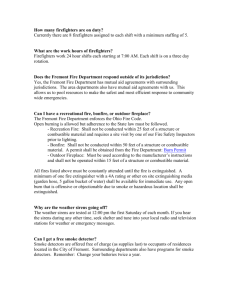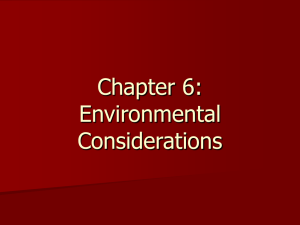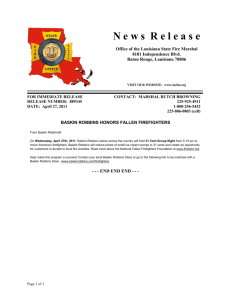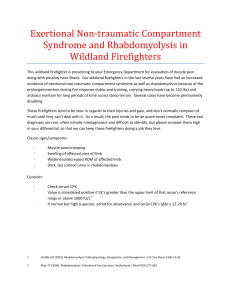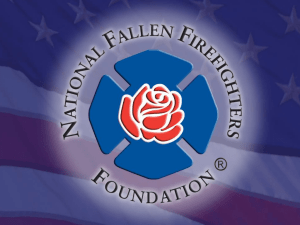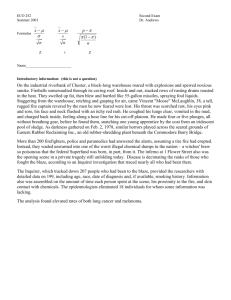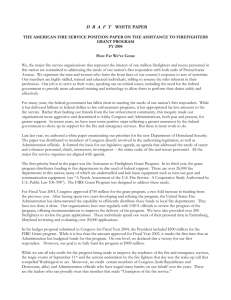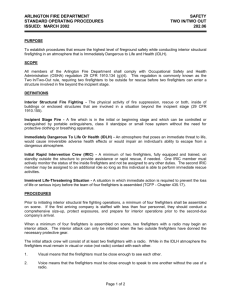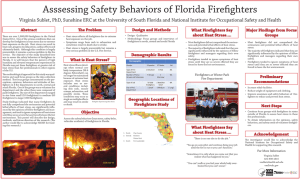Standard Operating Guidelines for Prevention and Treatment
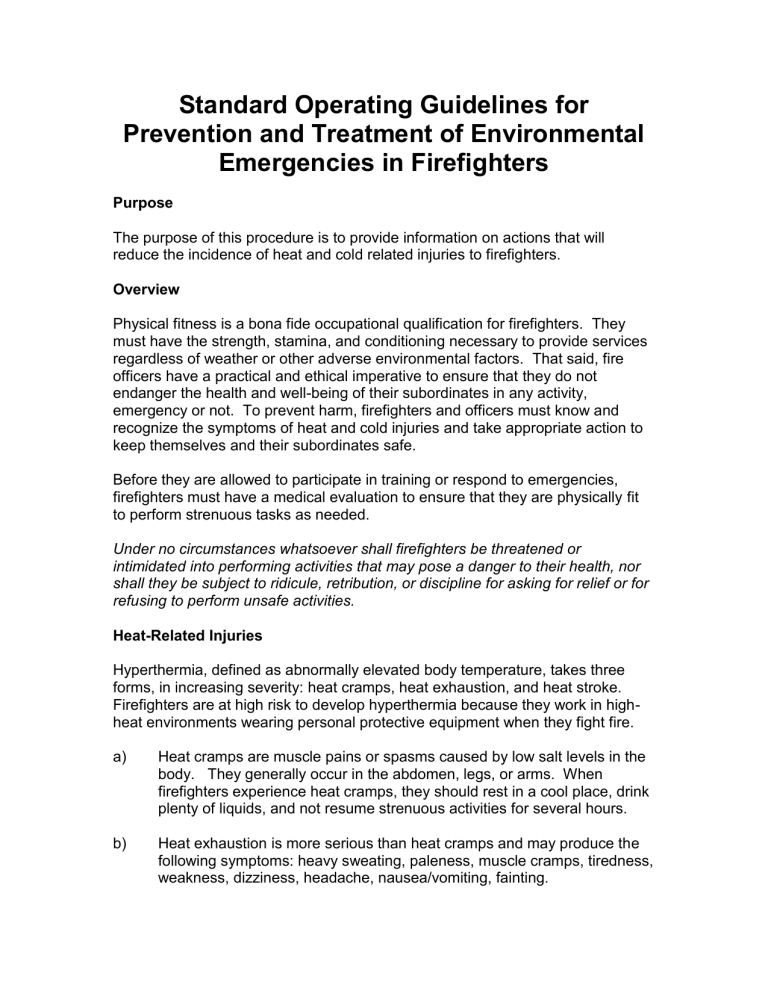
Standard Operating Guidelines for
Prevention and Treatment of Environmental
Emergencies in Firefighters
Purpose
The purpose of this procedure is to provide information on actions that will reduce the incidence of heat and cold related injuries to firefighters.
Overview
Physical fitness is a bona fide occupational qualification for firefighters. They must have the strength, stamina, and conditioning necessary to provide services regardless of weather or other adverse environmental factors. That said, fire officers have a practical and ethical imperative to ensure that they do not endanger the health and well-being of their subordinates in any activity, emergency or not. To prevent harm, firefighters and officers must know and recognize the symptoms of heat and cold injuries and take appropriate action to keep themselves and their subordinates safe.
Before they are allowed to participate in training or respond to emergencies, firefighters must have a medical evaluation to ensure that they are physically fit to perform strenuous tasks as needed.
Under no circumstances whatsoever shall firefighters be threatened or intimidated into performing activities that may pose a danger to their health, nor shall they be subject to ridicule, retribution, or discipline for asking for relief or for refusing to perform unsafe activities.
Heat-Related Injuries
Hyperthermia, defined as abnormally elevated body temperature, takes three forms, in increasing severity: heat cramps, heat exhaustion, and heat stroke.
Firefighters are at high risk to develop hyperthermia because they work in highheat environments wearing personal protective equipment when they fight fire. a) Heat cramps are muscle pains or spasms caused by low salt levels in the body. They generally occur in the abdomen, legs, or arms. When firefighters experience heat cramps, they should rest in a cool place, drink plenty of liquids, and not resume strenuous activities for several hours. b) Heat exhaustion is more serious than heat cramps and may produce the following symptoms: heavy sweating, paleness, muscle cramps, tiredness, weakness, dizziness, headache, nausea/vomiting, fainting.
c) Heat stroke is a true emergency that requires immediate medical treatment to forestall death. Symptoms include high body temperature, lack of sweating, with hot red or flushed skin, rapid pulse, difficulty breathing, strange behavior, hallucinations, confusion, agitation, disorientation, seizure, and coma. d) Firefighters who develop heat cramps or symptoms of heat exhaustion should not be allowed to return to emergency operations until the symptoms have been gone for at least an hour and they have rested for several hours. Their vital signs should be monitored during this time and for several following days to ensure that symptoms do not recur. e) A firefighter who exhibits symptoms of heat stroke should be transported to a hospital immediately for appropriate medical care. This condition cannot be adequately treated outside a hospital.
Cold-Related injuries
Hypothermia is defined as an abnormally low body temperature, below 95 degrees Fahrenheit. The differences among mild, moderate, and severe hypothermia are not always clear, but there is a constant sequence of events as core body temperature continues to decrease. a) At body temperatures below 95 degrees F, a victim will shiver. Symptoms include rapid heart rate and breathing rate. Blood pressure increases. b) As core body temperature continues to decline, pulse and breathing rates and blood pressure decrease. Symptoms may include clumsiness, apathy, confusion, and slurred speech. c) When core body temperature falls below 89.9 degrees F, shivering stops and oxygen consumption decreases. Symptoms include stupor and irregular heartbeat. d) At core body temperatures below 82.4 degrees F, reflexes are lost and cardiac output continues to decrease. The risk of dangerously irregular heartbeat increases, and brain activity significantly declines. The pupils are dilated and the victim appears to be comatose or dead. e) Frostbite is defined as the freezing of tissue. Most commonly affected are the nose, cheeks, ears, fingers, and toes.
1. The symptoms of superficial frostbite include burning, numbness, tingling, itching, or cold sensations of the affected areas. They look white and frozen but retain some resistance to pressure.
2. The symptoms of deep frostbite include decreased sensation until all sensation is lost. Skin appears to be white or yellowish and looks waxy. Swelling occurs and blood-filled blisters form.
3. Significant pain occurs as frostbitten areas are rewarmed. f) Neither hypothermia nor frostbite can be adequately treated in the field.
Victims must be dried and covered and quickly transported for medical treatment in a hospital.
Rehabilitation
Prevention of heat and cold injuries is the best strategy. Fire fighting teams should be rotated to rehabilitate when members have exhausted 1 cylinder of air.
At no point should a firefighter who has exhausted 2 cylinders be allowed to continue to work without resting. Rehab must include the following:
A. Rest and relief from extreme weather conditions in a place away from emergency operations and apart from decision-making about operations.
For hot conditions, the place should be shaded and cooling provided. In cold conditions, the place should be shielded from wind and heating provided. Seating should always be available.
B. Hydration with water and/or appropriate sports beverages and juices to replenish electrolytes lost through sweating. In hot conditions, the beverages should be lukewarm or cool. In cold conditions, they should be lukewarm or warm. Beverages containing alcohol or caffeine should not be provided.
C. In hot conditions, active cooling by submersion of hands and forearms in cool water. This technique has been shown to be the quickest way to cool the body. In cold conditions, clothing should be warmed and dried.
D. Medical monitoring of vital signs and body conditions to ensure that symptoms of heat and injury are quickly identified and appropriately treated.
E. Food to enable firefighters to replenish the calories expended in the emergency response. In hot conditions, energy bars are appropriate; in cold, soups and stews.

